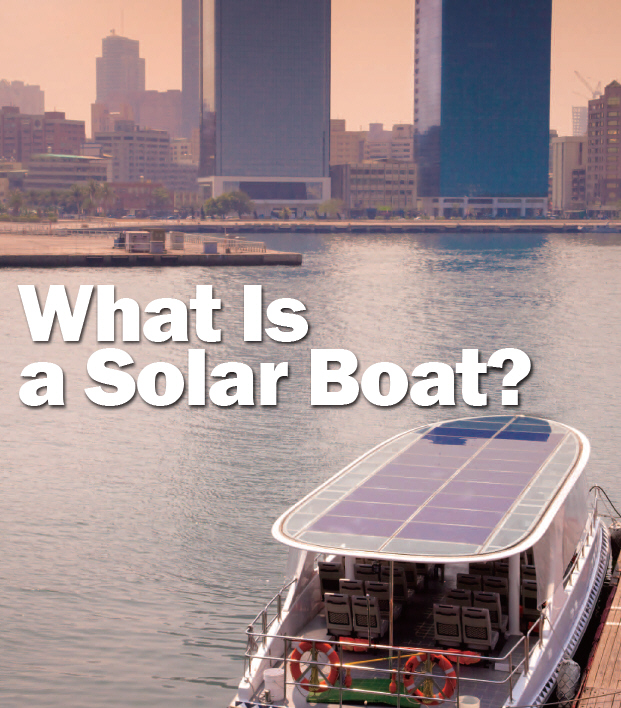By Paul Lynn

An eye-catching new craft, furnished with solar Photovoltaic (PV) modules, arrives at an electric boat rally. Onlookers naturally assume she is ‘solar-powered’. But what exactly does this mean, and how might we quantify the performance of a boat that uses sunlight for propulsion?
There is no easy answer. The viability of solar propulsion depends on the amount of PV carried, the motor power needed to achieve cruising speed, the intended pattern of use and--of course--the amount of local sunshine. In this article, I should like to examine these factors and propose a quantitative measure, the Solar Boat Index (SBI), to indicate the comparative performance of a wide variety of craft.
The nub of my proposal is that any boat which, on average, derives 1 hour per day, or 7 hours per week, of summer cruising from its PV modules deserves the accolade ‘solarpowered’.
Most users confine their boating to weekends, and 7 hours of weekend cruising is widely regarded as a reasonable amount for an electric leisure craft, whether solar or not. And I shall show that the criterion is met, in English summer conditions, provided the boat’s peak PV power is at least equal to one third the power required by its propulsion motor at normal cruising speed. This, in turn, will lead to a definition of the Solar Boat Index.
To illustrate the argument, let’s consider a boat having 0.5 kW peak of PV modules, mounted horizontally, and a propulsion motor that requires 1.5 kW to drive the boat at normal cruising speed. According to the above proposal, this boat will just meet the criterion of being ‘solar-powered’.
How much energy do the modules produce? In the summer months May to August in England, 0.5 kW of PV may be expected to deliver an average of about 1.5 kWh per day of usable stored energy to the boat’s batteries. And since the motor needs 1.5 kW at normal cruising speed, this solar input will clearly allow an average 1 hour cruising per day, or 7 hours at the weekend, assuming adequate battery storage.
But what is ‘normal’ speed? I should like to suggest 5 mph (8 kph), the speed limit on the river Thames, for boats based on rivers and lakes; and 4 mph (6.4 kph), the speed limit on the English canals, for barges and other canal boats. Most people would probably agree that these are realistic, and enjoyable, speeds at which to travel.
I now propose the following Solar Boat Index (SBI):
SBI = 3 (Ppv)/(Pm)
Where Ppv is the peak power in watts supplied by the PV panels, and Pm is the motor input power required to give a cruising speed of 5 mph (6.4 kph) on rivers and lakes, or 4 mph (6.4 kph) on canals. I have included the factor 3 in the definition so that a boat giving an average 7 hours of weekend cruising in England, which is just ‘solar-powered’, achieves an SBI of unity (1.0). This is easy to explain, discuss, and remember.
A further advantage is that a boat’s SBI value equals the expected number of cruising hours per day provided by its PV modules. For example, a boat with SBI = 2 gives an average 2 hours per day of solar cruising at ‘normal’ speed.
Let’s take some more examples of solar boats, this time real-life ones. My own catamaran Solar Flair, which completed the first solar voyage along the non-tidal Thames in 2003, has four 75 W PV panels, giving Ppv = 0.3 kW, and needs about 0.55 kW of motor power to travel at 5 mph (8 kph) in calm water. Her SBI is therefore equal to 3 x 0.3/0.55 = 1.64 (which, I note with relief, is comfortably above unity). The catamaran Collinda, in which Malcolm Moss made the first solar voyage across the English Channel in 1997, has a more impressive SBI of 2.8 making her well and truly ‘solar-powered’. And Cedric Lynch’s canoe, often seen running at unlikely speeds in weak sunlight, manages an SBI of 4.3. This one will be hard to beat!
We should also consider the local climate. Data for England should also apply reasonably well to countries such as Germany, Holland, and the northern half of France. A boat based in the south of France might get an additional 30% from its PV panels in summer, and one based in Spain or Australia perhaps 50% more. Such variations, as well as different patterns of use in different climates, should be taken into account when interpreting SBI values.
Finally, a few words of caution. An SBI value can only be an approximate indicator of performance because of the uncertainties surrounding the solar climate and a boat’s pattern of use. I therefore recommend that SBI’s should only be quoted to 2 significant figure accuracy. And we should avoid saying that a boat based in England and having an SBI of, say, 0.80 is definitely ‘not solar-powered’, or that one with an SBI of 1.2 ‘definitely is’. A little flexibility is required. With such provisos, I launch the SBI upon uncharted, but hopefully unruffled, waters.
Paul Lynn is former Technical Officer at Electric Boat Association (www.electric-boats.org.uk).
For more information, please send your e-mails to pved@infothe.com.
ⓒ2011 www.interpv.net All rights reserved. |



